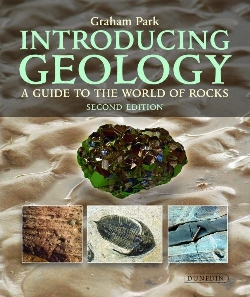Introducing Geology: A guide to the world of rocks (Second Edition)
Graham Park
Published by: Dunedin Academic Press
Publication date: 2010
ISBN: 978-1-906716-21-9
List price: £9.99
134 pp
www.dunedinacademicpress.co.uk

This book is well written in an easy to read and interesting style, with many good photographs and informative, well-drawn diagrams. It is suited to anyone starting out in geology, including GCSE students and those on A or AS Level courses. It is also particularly valuable to someone who has not practised their geology for a while and who wants a refresher, or to a non-specialist interested in things they read about in the press, such as gemstones, plate tectonics or the age of the Earth.
The text encourages people to look at the landscapes around them, the rocks in the landscapes and to try and understand how they developed. It has a logical structure, progressing from gemstones to igneous, metamorphic and sedimentary rocks, to fossils, earthquakes and folding and faulting. It then discusses continental drift, sea floor spreading, plate tectonics and why certain rocks ended up in certain places. Of particular interest to the general reader, I expect, will be the sections on mountain building, metamorphism, hotspots, earthquakes, the main groups of fossils and mass extinctions.
The book also discusses the history of the Earth from the Hadean to the Cenozoic. It makes the observation that there is much speculation about the existence and extent of human-induced global warming, and that it is hard to judge this against the extremes of climatic variation observed through geological time. The author then points out that what is worrying and easier to measure and predict is the mass extinction that is presently under way as a result of human exploitation.
Finally the author explores the relationship between geology and industry. Everyone – certainly all readers of this magazine – will be familiar with the role that geology has played in the location and extraction of the highly valuable reserves of oil and gas that underpin our civilisation. The various modes of formation of valuable ore deposits (e.g. hydrothermal and residual deposits) are also discussed, together with their detection by both traditional and modern prospecting methods, including geophysical and geochemical techniques. The book also discusses extractive industries (coal, building stone, cement and aggregate) that have been central to energy production and the construction industry for hundreds of years.
The book includes a comprehensive glossary. It is well bound and the print quality is excellent, making it very good value at £9.99.
Steve Rowlatt
Bishop’s Stortford